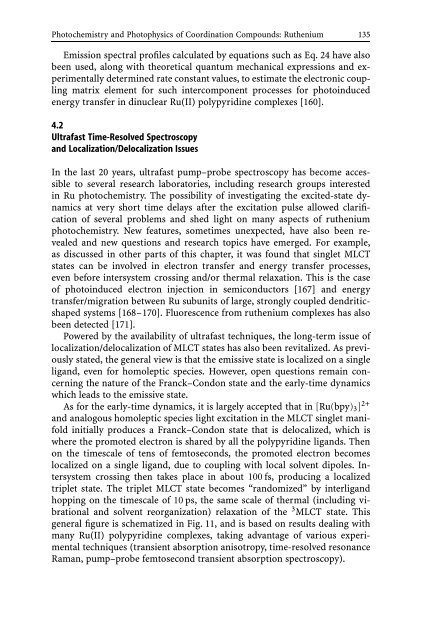Photochemistry and Photophysics of Coordination Compounds
Photochemistry and Photophysics of Coordination Compounds
Photochemistry and Photophysics of Coordination Compounds
You also want an ePaper? Increase the reach of your titles
YUMPU automatically turns print PDFs into web optimized ePapers that Google loves.
<strong>Photochemistry</strong> <strong>and</strong> <strong>Photophysics</strong> <strong>of</strong> <strong>Coordination</strong> <strong>Compounds</strong>: Ruthenium 135<br />
Emission spectral pr<strong>of</strong>iles calculated by equations such as Eq. 24 have also<br />
been used, along with theoretical quantum mechanical expressions <strong>and</strong> experimentally<br />
determined rate constant values, to estimate the electronic coupling<br />
matrix element for such intercomponent processes for photoinduced<br />
energy transfer in dinuclear Ru(II) polypyridine complexes [160].<br />
4.2<br />
Ultrafast Time-Resolved Spectroscopy<br />
<strong>and</strong> Localization/Delocalization Issues<br />
In the last 20 years, ultrafast pump–probe spectroscopy has become accessible<br />
to several research laboratories, including research groups interested<br />
in Ru photochemistry. The possibility <strong>of</strong> investigating the excited-state dynamics<br />
at very short time delays after the excitation pulse allowed clarification<br />
<strong>of</strong> several problems <strong>and</strong> shed light on many aspects <strong>of</strong> ruthenium<br />
photochemistry. New features, sometimes unexpected, have also been revealed<br />
<strong>and</strong> new questions <strong>and</strong> research topics have emerged. For example,<br />
as discussed in other parts <strong>of</strong> this chapter, it was found that singlet MLCT<br />
states can be involved in electron transfer <strong>and</strong> energy transfer processes,<br />
even before intersystem crossing <strong>and</strong>/or thermal relaxation. This is the case<br />
<strong>of</strong> photoinduced electron injection in semiconductors [167] <strong>and</strong> energy<br />
transfer/migration between Ru subunits <strong>of</strong> large, strongly coupled dendriticshaped<br />
systems [168–170]. Fluorescence from ruthenium complexes has also<br />
been detected [171].<br />
Powered by the availability <strong>of</strong> ultrafast techniques, the long-term issue <strong>of</strong><br />
localization/delocalization <strong>of</strong> MLCT states has also been revitalized. As previously<br />
stated, the general view is that the emissive state is localized on a single<br />
lig<strong>and</strong>, even for homoleptic species. However, open questions remain concerning<br />
the nature <strong>of</strong> the Franck–Condon state <strong>and</strong> the early-time dynamics<br />
which leads to the emissive state.<br />
As for the early-time dynamics, it is largely accepted that in [Ru(bpy)3] 2+<br />
<strong>and</strong> analogous homoleptic species light excitation in the MLCT singlet manifold<br />
initially produces a Franck–Condon state that is delocalized, which is<br />
where the promoted electron is shared by all the polypyridine lig<strong>and</strong>s. Then<br />
on the timescale <strong>of</strong> tens <strong>of</strong> femtoseconds, the promoted electron becomes<br />
localized on a single lig<strong>and</strong>, due to coupling with local solvent dipoles. Intersystem<br />
crossing then takes place in about 100 fs, producing a localized<br />
triplet state. The triplet MLCT state becomes “r<strong>and</strong>omized” by interlig<strong>and</strong><br />
hopping on the timescale <strong>of</strong> 10 ps, the same scale <strong>of</strong> thermal (including vibrational<br />
<strong>and</strong> solvent reorganization) relaxation <strong>of</strong> the 3 MLCT state. This<br />
general figure is schematized in Fig. 11, <strong>and</strong> is based on results dealing with<br />
many Ru(II) polypyridine complexes, taking advantage <strong>of</strong> various experimental<br />
techniques (transient absorption anisotropy, time-resolved resonance<br />
Raman, pump–probe femtosecond transient absorption spectroscopy).

















